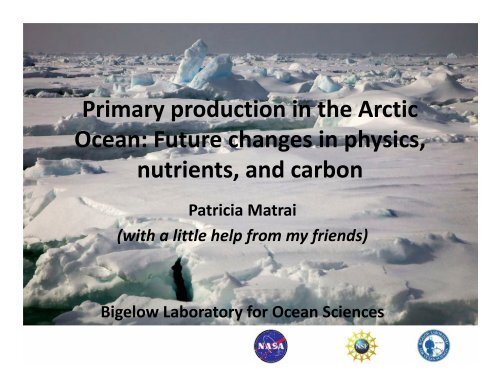Primary production in the Arctic Ocean: Future changes in physics ...
Primary production in the Arctic Ocean: Future changes in physics ...
Primary production in the Arctic Ocean: Future changes in physics ...
You also want an ePaper? Increase the reach of your titles
YUMPU automatically turns print PDFs into web optimized ePapers that Google loves.
<strong>Primary</strong><strong>production</strong><strong>in</strong><strong>the</strong><strong>Arctic</strong><br />
<strong>Ocean</strong>:<strong>Future</strong><strong>changes</strong><strong>in</strong><strong>physics</strong>,<br />
nutrients,andcarbon<br />
PatriciaMatrai<br />
(withalittlehelpfrommyfriends)<br />
BigelowLaboratoryfor<strong>Ocean</strong>Sciences
Foto:NationalGeographic
Photo: MikeBritta<strong>in</strong>
SwissGlobalChangeDay2013Bern<br />
Whatare<strong>the</strong>se<br />
(charismaticmegafauna)<br />
resourcesbasedupon?
Charismatic microflora!<br />
Plant (phyto) plankton: Different diatoms<br />
(hundred micrometres <strong>in</strong> size, sta<strong>in</strong>ed)<br />
SwissGlobalChangeDay2013Bern
SwissGlobalChangeDay2013Bern<br />
Phytoplankton
Howcanproductivitybe<strong>in</strong>fluencedbychange?<br />
1. Bottomup effects:<br />
Environmental change affects consumers<br />
by modulat<strong>in</strong>g <strong>the</strong> productivity, tim<strong>in</strong>g<br />
and/or size of primary producers.<br />
2.Topdowneffects:<br />
Alteredpredationbyconsumeraffects<br />
<strong>the</strong>structureand/orproductivityof<br />
lowerfoodweb.<br />
SwissGlobalChangeDay2013Bern (F<strong>in</strong>kel etal.2009,JPlk Res) CourtesyJETremblay
Bottomupchange:lessice=morelight<br />
1.Extent(Septemberm<strong>in</strong>imum) 2.Age(thickness)<br />
Source:NSDIC<br />
SwissGlobalChangeDay2013Bern<br />
Source:NSDIC<br />
3.Seasonalpersistence<br />
ofannualice:2to13<br />
daysperdecade<br />
years<br />
<strong>Primary</strong><strong>production</strong>patternsarenotasimplefunctionoflight<br />
Meanannual<strong>in</strong>cident<br />
<strong>in</strong>solation(20350Wm 2 )<br />
Kallberg etal.(2005).<br />
SwissGlobalChangeDay2013Bern<br />
<strong>Primary</strong>Production<br />
?<br />
Light<br />
Meanannualchlorophyll<br />
(=phytoplanktonbiomass)<br />
NASA<br />
CourtesyJETremblay
Ice melt and surface<br />
warm<strong>in</strong>g result <strong>in</strong><br />
stratification that<br />
prevents vertical<br />
mix<strong>in</strong>g<br />
Low nutrient supply<br />
to surface and thus<br />
low harvestable<br />
productivity<br />
Deepoceanarea<br />
nutrients<br />
sediment<br />
SwissGlobalChangeDay2013Bern CourtesyPWassmann
Howdeep?<br />
Seasonaldistributionofeuphoticzoneandmixed<br />
layerdepthsfromspr<strong>in</strong>gtofall<strong>in</strong><strong>the</strong><strong>Arctic</strong><strong>Ocean</strong><br />
Euphoticzonedepth[m]=>Light<br />
Nodata<br />
100 0<br />
Mixedlayerdepth[m]=>Nutrients<br />
Satellitebasedandfielddata<br />
monthlyaverages(19982007)<br />
April<br />
May<br />
June<br />
July<br />
August<br />
September<br />
SwissGlobalChangeDay2013Bern<br />
Hill,Matrai etal.2013
Today sextreme<br />
Sameamount<br />
Sameamount seasonal<br />
ofnutrients ofnutrients variation<br />
disappears<br />
Same Same<br />
harvestable<br />
harvestable<br />
<strong>production</strong><br />
SwissGlobalChangeDay2013Bern<br />
Wassmann 2011,andthosebeforehim
Whereis<strong>Arctic</strong><strong>Primary</strong>Productionnow?
IntegratedAnnualNet<strong>Primary</strong>Production(PP)<br />
(19542007field;19982007satellitedata)<br />
SwissGlobalChangeDay2013Bern<br />
AlgorithmestimatedNPPbasedon:<br />
FieldChl SatChl<br />
0-100 gC m -2 yr -1<br />
Hill,Matrai etal.2013
NetCommunityProduction<br />
=<br />
NCP*f factor=NPP(orNP?)<br />
(0200)<br />
(040)gC m2 yr1 SwissGlobalChangeDay2013Bern<br />
10<br />
0<br />
30<br />
10<br />
Codispoti ,Matrai etal.2013<br />
5<br />
0
Abiologicalmodelappliedregionally<br />
Panarcticdecadaltrend<br />
Pabi etal.2008<br />
Arrigo andvanDijken 2011<br />
us<strong>in</strong>gsatellitedata<br />
Variableregionaldecadaltrends<br />
H<strong>in</strong>dcast<strong>in</strong>g <strong>in</strong>to<strong>the</strong>1970s
Pan<strong>Arctic</strong>representationof<strong>the</strong>present<br />
MeanannualwatercolumnPP[gC m 2 y 1 ]by5modelsandasatellitederivedestimate<br />
Popova etal.2010 Dealetal.2011 Zhangetal.2010<br />
Dupont etal.2012 Yool etal.2011<br />
SwissGlobalChangeDay2013Bern<br />
field<br />
data?
Realitycheckorvalidation<br />
• Ourprojectionsareonlyasgoodasourdataare:<br />
– Enoughbiologicaldatatovalidate?<br />
• Yearround;arcticwide;undericeandiceedgeblooms<br />
– Appropiate physicalandbiologicalmodels?<br />
• Currentparameterizationsofmixedlayerdepth, nutrient<br />
fields,verticaldistributionofphytoplanktonbiomass<br />
– Factorswithnew orun<strong>in</strong>tendedeffects?<br />
• Clouds,w<strong>in</strong>ds,freshwaterstratification
SwissGlobalChangeDay2013Bern<br />
IntegratedAnnualNPP<br />
ARCSSPP&nutrientsdatasets19542007<br />
(www.nodc.noaa.gov)<br />
Hill,Matrai etal.2013<br />
AlsoseeArdyna etal.2013BGD
Subsurfacechlorophyllmaximum<br />
(=phytoplanktonbiomass):<br />
seasonalandregionalvs.annualandpanarcticscales<br />
Whereare<br />
<strong>the</strong>phytos<br />
and<br />
when?<br />
Depth[m]<br />
0 350days<br />
Chl (mgm 3 )<br />
Ardyna etal.2013BGD<br />
andalso<br />
Hill,Matrai etal.2013<br />
Arrigo,Matrai,vanDijken 2011
Modeledmixedlayerdep<strong>the</strong>xamples<br />
SwissGlobalChangeDay2013Bern<br />
Popova etal.2012<br />
Same<br />
forDIN<br />
fields
Lightdecrease<br />
(820%)<br />
(+clouds)<br />
(19982009)<br />
ABOVEsea<br />
(ice)surface<br />
SwissGlobalChangeDay2013Bern<br />
Cloudsandlight<br />
%yr 1<br />
Lightchange(+3<br />
to 3%)(1998<br />
2009)JUST<br />
BELOW<br />
sea(ice?)surface<br />
PP<strong>in</strong>crease<br />
(19982009)<br />
estimated<br />
belowsea<br />
(ice?)surface<br />
Bélanger etal.2012BGD
W<strong>in</strong>d!=>w<strong>in</strong>ddriventurbulenceand<br />
eddies=>mix<strong>in</strong>g,nitrateconsumption<br />
Withicevs.WithoutIce Woodgate,Ra<strong>in</strong>ville,Mahadevan,<br />
Wang,Matrai,<strong>in</strong>prep<br />
Muchtobedoneon<strong>the</strong>model<strong>in</strong>gside:<br />
AOMIP<br />
(http://www.whoi.edu/page.do?pid=29836)<br />
4 th <strong>Primary</strong>ProductionAlgorithmRoundRob<strong>in</strong><br />
(contactpmatrai@bigelow.org)
Summary<br />
• Seaiceisth<strong>in</strong>n<strong>in</strong>gandextentisreduced,especially<strong>in</strong>summer<br />
• <strong>Primary</strong><strong>production</strong>seasonisexpectedto<strong>in</strong>crease<strong>in</strong>duration<br />
(light)butnot<strong>in</strong>magnitude(nutrients)atpanarcticscales<br />
• <strong>Primary</strong><strong>production</strong>andproductivity<strong>in</strong>crease<strong>in</strong>certa<strong>in</strong><br />
cont<strong>in</strong>entalshelvesandbreaks; andmove=>Whose<br />
fisheries!?<br />
• <strong>Primary</strong><strong>production</strong>andproductivityisnotexpectedto<br />
<strong>in</strong>crease<strong>in</strong><strong>the</strong>deep<strong>Arctic</strong>Bas<strong>in</strong>(notenoughnutrients)<br />
• Theecosystemsof<strong>the</strong><strong>Arctic</strong><strong>Ocean</strong>willchange<strong>the</strong>irpresent<br />
dayequilibrium. Wedonotknowhow<strong>the</strong>newequilibrium<br />
willsupportecosystemservices<br />
• Ourpredictionsareonlyasgoodasourvalidat<strong>in</strong>gdataand<br />
processunderstand<strong>in</strong>gare
Thankyou!

















